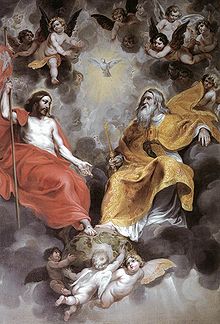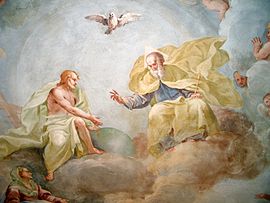
Back Iconografía de la Trinidad Spanish Tritunggal dalam seni rupa ID Iconografia della Trinità Italian


The Trinity is most commonly seen in Christian art with the Holy Spirit represented by a dove, as specified in the gospel accounts of the baptism of Christ; he is nearly always shown with wings outspread. However depictions using three anthropomorphic figures appear occasionally in most periods of art.[1]
The Father and the Son are usually differentiated by age, and later by dress, but this too is not always the case. The usual depiction of the Father as an older man with a white beard may derive from the biblical Ancient of Days, which is often cited in defense of this sometimes controversial representation. However, in Eastern Orthodoxy the Ancient of Days is usually understood to be God the Son, not God the Father—early Byzantine images show Christ as the Ancient of Days,[2] but this iconography became rare. When the Father is depicted in art, he is sometimes shown with a halo shaped like an equilateral triangle, instead of a circle. The Son is often shown at the Father's right hand.[3] He may be represented by a symbol—typically the Lamb or a cross—or on a crucifix, so that the Father is the only human figure shown at full size. In early medieval art, the Father may be represented by a hand appearing from a cloud in a blessing gesture, for example in scenes of the Baptism of Christ. Later, in the West, the "Throne of Mercy" (or "Throne of Grace") became a common depiction. In this style, the Father (sometimes seated on a throne) is shown supporting either a crucifix[4] or, later, a slumped crucified Son, similar to the Pietà (this type is distinguished in German as the Not Gottes)[5] in his outstretched arms, while the Dove hovers above or in between them. This subject continued to be popular until the 18th century at least.
By the end of the 15th century, larger representations, other than the Throne of Mercy, became effectively standardised, showing an older figure in plain robes for the Father, Christ with his torso partly bare to display the wounds of his Passion, and the dove above or around them. In earlier representations both Father, especially, and Son often wear elaborate robes and crowns. Sometimes the Father alone wears a crown, or even a papal tiara.
- ^ See below and G Schiller, Iconography of Christian Art, Vol. I, 1971, Vol II, 1972, (English trans from German), Lund Humphries, London, figs I;5–16 & passim, ISBN 0-85331-270-2 and ISBN 0-85331-324-5
- ^ Cartlidge, David R., and Elliott, J.K.. Art and the Christian Apocrypha, pp. 69–72 (illustrating examples), Routledge, 2001, ISBN 0-415-23392-5, ISBN 978-0-415-23392-7, Google books
- ^ Acts 7:56
- ^ G Schiller, Iconography of Christian Art, Vol. II, 1972, (English trans from German), Lund Humphries, London, figs I;5–16 & passim, ISBN 0-85331-270-2 and ISBN 0-85331-324-5, pp. 122–124 and figs 409–414
- ^ G Schiller, Iconography of Christian Art, Vol. II, 1972, (English trans from German), Lund Humphries, London, figs I;5–16 & passim, ISBN 0-85331-270-2 and ISBN 0-85331-324-5, pp. 219–224 and figs 768–804